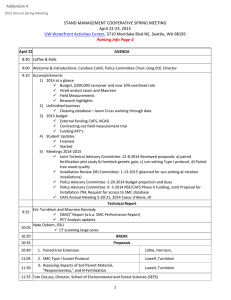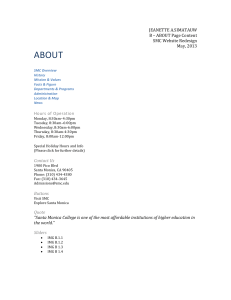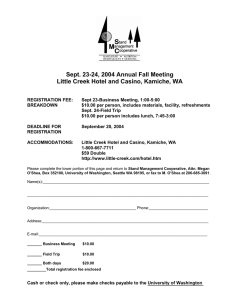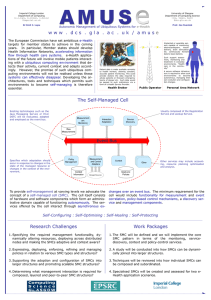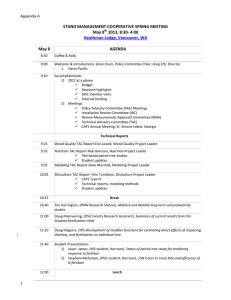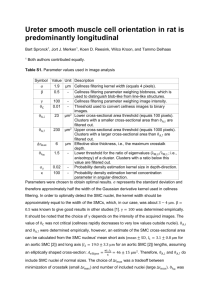Gifford Pinchot National Forest Headquarters in Vancouver, WA. April 19, 2012
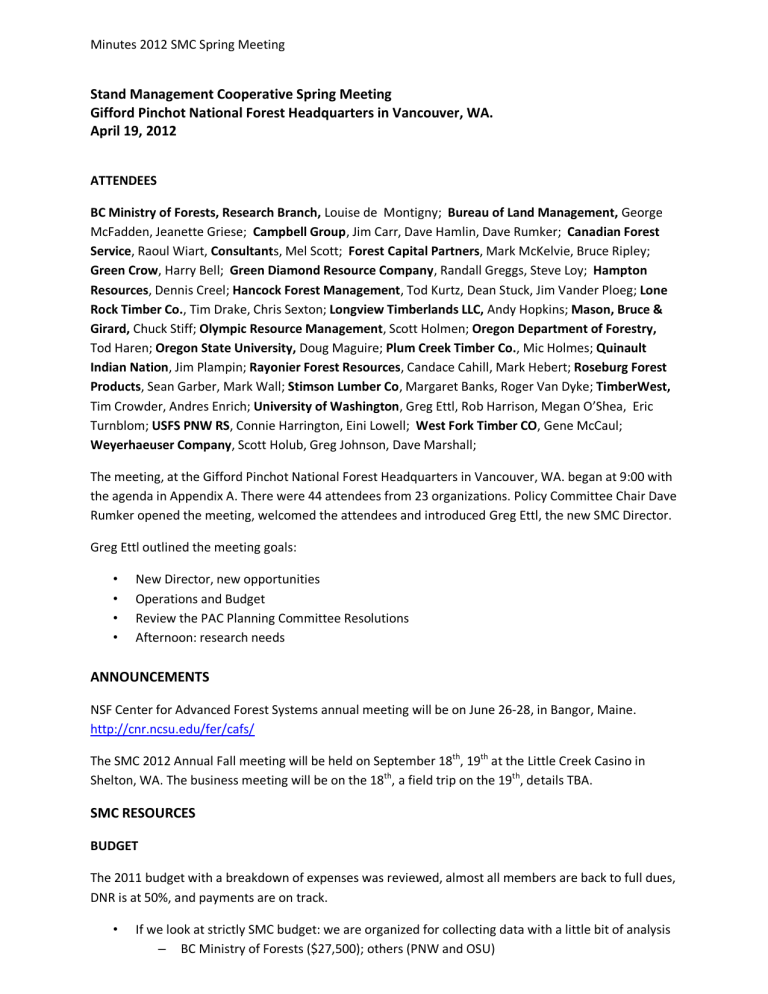
Minutes 2012 SMC Spring Meeting
Stand Management Cooperative Spring Meeting
Gifford Pinchot National Forest Headquarters in Vancouver, WA.
April 19, 2012
ATTENDEES
BC Ministry of Forests, Research Branch, Louise de Montigny; Bureau of Land Management, George
McFadden, Jeanette Griese; Campbell Group , Jim Carr, Dave Hamlin, Dave Rumker; Canadian Forest
Service , Raoul Wiart, Consultant s, Mel Scott; Forest Capital Partners , Mark McKelvie, Bruce Ripley;
Green Crow , Harry Bell; Green Diamond Resource Company , Randall Greggs, Steve Loy; Hampton
Resources , Dennis Creel; Hancock Forest Management , Tod Kurtz, Dean Stuck, Jim Vander Ploeg; Lone
Rock Timber Co.
, Tim Drake, Chris Sexton; Longview Timberlands LLC, Andy Hopkins; Mason, Bruce &
Girard, Chuck Stiff; Olympic Resource Management , Scott Holmen; Oregon Department of Forestry,
Tod Haren; Oregon State University, Doug Maguire; Plum Creek Timber Co.
, Mic Holmes; Quinault
Indian Nation , Jim Plampin; Rayonier Forest Resources , Candace Cahill, Mark Hebert; Roseburg Forest
Products , Sean Garber, Mark Wall; Stimson Lumber Co , Margaret Banks, Roger Van Dyke; TimberWest,
Tim Crowder, Andres Enrich; University of Washington , Greg Ettl, Rob Harrison, Megan O’Shea, Eric
Turnblom; USFS PNW RS , Connie Harrington, Eini Lowell; West Fork Timber CO , Gene McCaul;
Weyerhaeuser Company , Scott Holub, Greg Johnson, Dave Marshall;
The meeting, at the Gifford Pinchot National Forest Headquarters in Vancouver, WA. began at 9:00 with the agenda in Appendix A. There were 44 attendees from 23 organizations.
Policy Committee Chair Dave
Rumker opened the meeting, welcomed the attendees and introduced Greg Ettl, the new SMC Director.
Greg Ettl outlined the meeting goals:
•
New Director, new opportunities
•
Operations and Budget
•
Review the PAC Planning Committee Resolutions
•
Afternoon: research needs
ANNOUNCEMENTS
NSF Center for Advanced Forest Systems annual meeting will be on June 26-28, in Bangor, Maine. http://cnr.ncsu.edu/fer/cafs/
The SMC 2012 Annual Fall meeting will be held on September 18 th
, 19 th
at the Little Creek Casino in
Shelton, WA. The business meeting will be on the 18 th
, a field trip on the 19 th
, details TBA.
SMC RESOURCES
BUDGET
The 2011 budget with a breakdown of expenses was reviewed, almost all members are back to full dues,
DNR is at 50%, and payments are on track.
•
If we look at strictly SMC budget: we are organized for collecting data with a little bit of analysis
–
BC Ministry of Forests ($27,500); others (PNW and OSU)
Minutes 2012 SMC Spring Meeting
–
Dues in 2011 $570,207
•
UW Facilities, Accounting, and Administrative overhead: $147,474 (26% as per agreement)
•
Data Collection: $156,361 (Bob, Bert, 3 rd
person salaries and benefits); $58,369
(travel expenses and maintenance equipment)
•
Data processing and administration: $116,652, Megan (1/2) and Randy’s salaries and benefits
•
Faculty Salaries and Benefits: Briggs, Harrison, Turnblom for between 1.5 and 2 months/y ($57,642)
•
The remaining $31,000 was spent on:
– student summer projects, Kim’s installations and vegetation measurement project, RA quarter
–
UW charges, yes even with overhead we get charged some fees
L EVERAGED R ESOURCES
•
A number of research assets have been involved in ongoing SMC research efforts
–
3 UW Faculty lines involved in SMC
–
Faculty direct student research
•
Teaching Assistantships (4-6 graduate students of funding--$120,000 in kind)
•
Corkery Chair (Ettl), >$100,000/y but not all for SMC; 3-year renewable
–
CAFS ($70,000), up for renewal next year; opportunity for new research initiatives
Comments: It was recommended members have access to the CAFS RFP template to submit proposals to the PAC for review. The PAC will recommend priorities for discussion at the spring meeting in preparation for the 2013 NSF CAFS summer meeting. Rob and
Eric will be submitting proposals to extend their funding for 2012 at the June meeting.
–
Numerous outside grants and contracts: $195,078 for 2011 from the NSF grant to purchase
15
N and manufacture
–
Other outside funding can dovetail w/ SMC priorities
B REAKDOWN OF D ATA C OLLECTION E FFORTS
•
40% Scheduled measuring Type I, II, III, IV, and V plots
•
10% Mid cycle RD checks and marking for thinning
•
5% Plot Maintenance
•
10% Foliage/soils collections
•
10% Plot treatments (thinning, pruning, fertilizing)
•
75% Remeasurements and dormant season work
•
10% New plot establishment (includes site location, surveying, tagging, etc.)
•
10% Special projects
•
5% Graduate student support
•
25% On other work
•
100% Total
Comments: The SMC is organized for collecting data with a little bit of analysis but the need is shifting towards more technology transfer and analyses. In the past data and information on growth and yield have been the driving force for membership, with quality data collection the core of the
Minutes 2012 SMC Spring Meeting
SMC , Greg proposed forming a committee to develop a tactical plan for sun-setting or decreasing the frequency of measurements on installations. Data needs to be prioritized; managers have a responsibility to maintain plots put in the 60’s-70’s, it’s important to continue with our quality data collection.
D ATA M ANAGEMENT AND R ESEARCH F LOW
•
Annual Report: June after data entered
•
SMC data DVD distributed in June after incorporation of all the plot measurements
•
Projects funded and supported by other sources
•
Faculty does research all year but summer is only time funded by SMC budgets.
–
Students not always in classes—thesis/dissertation data collection
–
Student research is on 2-4 year schedule (slow by comparison of dedicated research staff projects)
–
Research updates at meetings, newsletters, and manuscripts
PAC PLANNING MEETING
Since the 2011 Annual Fall Meeting there have been 2 Strategic Planning meetings to discuss the mission, vision, and goals that will carry the SMC into the future.
M ISSION S TATEMENT
•
ARTICLE II: Mission
•
The Mission of the SMC is “To provide a continuing source of high-quality data and information on the longterm effects of silvicultural treatments and treatment regimes on stand and tree growth and development and on wood and product quality.”
•
Proposed Change
•
The Mission of the SMC is “To provide a continuing source of high-quality data, analysis, and outputs on the long-term effects of silvicultural treatments and treatment regimes on stand and tree growth and development , and on wood and product quality.
Comments: Change in the Mission Statement implies the coop is moving form data collection to data analysis, end user tools and products. The challenge is to come up with creative solutions to outputs, can the outputs be more specific which in turn would translate into more funding from members.
M EMBERSHIP D UES
•
PAC discussed the potential of funding projects through:
–
Raising dues
–
Special project assessment
–
Decided to make no changes
Comments: Members felt they needed a better idea of what the outputs would be before voting for an increase in dues
R EVIEWING AND V OTING M EMBERSHIP
•
Article VII gives land management organizations, analytic organizations, and institutions all voting rights
Minutes 2012 SMC Spring Meeting
•
Proposed Change
•
We discussed the reason for this rule and it was decided we should move toward only having dues paying members (in-kind counts) as voting members
Non-paying members defined as Analytic Organizations and Suppliers must submit a yearly request form to maintain active membership in the SMC. Greg will contact non-paying members to discuss their contribution and continued involvement with the coop.
Comments: The question was asked if Analytic Organizations that provide decision-support services to members should pay a nominal fee along with the yearly membership request. No conclusion was reached. ORGANON as SMC modeling platform
•
After discussing which modeling platform the SMC should support, members voted in favor of supporting ORGANON, 19 Yes, 0 No.
Comments: CIPS collaborating with the Silviculture TAC on growth model evaluation.
Greg noted that the SMC is not an R&D, the kind of analysis and tool members seem interested in are on the development side and it will be hard to publish this type of analysis in peer-related journals.
Would it be better to make the data usable to each member so they can tailor the analysis and tool development to their individual needs?
RESEARCH UPDATES
W OOD Q UALITY TAC R EPORT : E INI L OWELL
•
No Wood Quality meeting in 2011
•
LOGS Study Update
–
Resistograph data processed
–
Historical data from all the stands has been gathered together
–
Weather data has also been collected and plans are to use Climate WNA (interpolation model similar to PRISM)
–
X-ray data completed
–
Need Douglas-fir samples for NIR calibration model
•
Presentations
–
“Assessment of wood quality and fibre properties in intensively managed Douglas-fir plantations using NDT tools” will be made by Cosmin Filipescu at the IUFRO All-Division
5 Conference, Estoril, Portugal (7/8-13/2012) with Ross Koppenaal, Eini Lowell, and
David Briggs as co-authors.
–
“What do we know about the effects of silviculture and genetics on branches/knots:
Douglas-fir as a case study” will be made by Maguire at the IUFRO All-Division 5
Conference, Estoril, Portugal (7/8-13/2012) with Dave Briggs, Keith Jayawickrama, Eini
Lowell, Eric Turnblum, and Terrence Ye as co-authors.
•
Agenda 2020 (2004) data, update on (veneer) analysis with SCION
–
Published:
•
Todoroki, C.L., Lowell, E.C., Dykstra, D.P. and Briggs, D.G. 2012. Maps and models of density and stiffness within individual Douglas-fir trees. New Zealand
Journal of Forestry Sciences. 42:1-13.
•
Submitted to Annals of Forest Science:
•
Lowell, E.C., Todoroki, C.L., Dykstra. D.P. and Briggs, D.G. 201x. Douglas-fir stiffness in response to thinning.
(based only on veneer data from Installation 803, Beeville Loop)
Minutes 2012 SMC Spring Meeting
–
In preparation:
•
Analysing x-ray densitometry profiles for thinning response
•
Agenda 2020 (2004) data Update on lumber analysis
–
In preparation:
•
Characteristics of Douglas-fir lumber produced under various thinning regimes.
Lowell, E.C., Huang, C.L., Briggs, D.G. and Dykstra, D.P.
•
Agenda 2020 (2008)
– aka Paired Tree Study, SMC-CIPS
–
Wood quality work to be coordinated through SMC at a later date (NDT/SG/?)
•
The Effects of Planting Density on Branch Size: Linkages to Wood Quality
–
Jed Bryce, UW student, working on a Masters with Eric Turnblum and Dave Briggs modeling the diameter of the largest branch at BH (DLLBH) in the Type III installations.
•
Northwest Advanced Renewables Alliance (NARA)
–
SMC NARA members:
•
Doug Maguire, Feedstock, Greg Johnson, Feedstock, Rob Harrison, Feedstock,
Sustainability Measurement and Eini Lowell, Outreach Team
–
This is part of a larger AFRI (Agriculture and Food Research Initiative) grant to produce aviation jet fuel from biomass that has both a westside and eastside feedstock component
–
Douglas-fir trees from SMC Type I installation buffer zones is one raw material the
Feedstock team is testing
–
Destructively sampled for chemical composition analysis
–
Data will augment the SMC database with additional wood quality data at a much higher resolution (chemical composition)
M ODELING TAC R EPORT : D AVE M ARSHALL
•
Last meeting: August 25, 2011
–
Role of “standing” SMC Modeling TAC
–
Next modeling project and need for funding
–
Strategic guidance from the SMC
–
Cooperator modeling needs
–
Technology transfer opportunities
–
How future work will be supported
•
FVS Activities (Erin Smith-Mateja)
–
FVS Conference April 17-19, 2012)
–
The FVS-ORGANON project (funded by the BLM) is marching along. Jeff is putting on some final touches and then the code will be transferred to our repository, where we will serve up the product. I have a short list of folks who have contacted me who want to be testers. I’ll be sending those people a note in the next week or so. Let people know that they can send me an email and I’ll add them to the list (contact Erin Smith-
Mateja).
–
In addition next fall we will start a project to plug in the CONIFERS DLL into FVS as well.
–
Peter Gould (PNW Olympia) is working on new small tree (less than 3”) growth equations, height and diameter, for most of the major species in the PN and WC variants.
•
ORGANON Activities (David Hann)
Minutes 2012 SMC Spring Meeting
–
Code updated 1/23/2012 with new stump diameter equations and corrected errors in the ORGANON-RAP in volume and wood quality
–
Source code is available from ORGANON web site
•
CIPS Activities (Doug Maguire)
–
CIPS technical Review meeting: May 3 in Corvallis
– beta version of CIPS/VMRC variant of CONIFERS
– upcoming CIPS Technical Review on May 3 to solicit feedback on analyses started and/or completed to date
– logistical assistance to Rich Howard to get thinning and fertilization into Assisi Manager
(ORGANON)
–
CIPS progress on new young stand growth equations that account for differential effects of competing vegetation life forms
–
Data from SMC Type I installations will be used by Kristin Coons in her M.S. thesis
(managed stand biomass equations, nutrient pools, nutrient depletion)
–
CONIFERS
•
Contact: Martin Ritchie (mritchie@fs.fed.us)
• http://www.fs.fed.us/psw/programs/ecology_of_western_forests/projects/coni fers/
–
FVS
•
Contact: Erin Smith-Mateja (eesmith@fs.fed.us)
• http://www.fs.fed.us/fmsc/
–
ORGANON
•
Contact: David Hann (david.hann@oregonstate.edu)
• http://www.cof.orst.edu/cof/fr/research/organon/
N UTRITION TAC R EPORT : R OB H ARRISON
•
No Nutrition meeting in 2011
•
Carryover Study
–
Paul Footen (M.S. finished March 2011) found small but statistically significant differences in mean DBH and height after about the 5th year since planting, also understory differences
–
Publications
• http://soilslab.cfr.washington/edu/publications/Footen-etal-2009.pdf
• http://soilslab.cfr.washington/edu/publications/FootenPaul-thesis-2011.pdf
–
Continuing and trying to expand
–
Funding is primarily from TA/Gessel and sample analysis/travel paid from SMC
•
Paired-Tree/15N
–
Funding: $32K from CAFS in 2012
–
Proposed: $30,682 for 2013
–
Kim Littke graduating June, 2012
–
Publications
•
Littke, KM, RB Harrison, DG Briggs and AR Grider. 2011. Understanding soil nutrients and characteristics in the Pacific Northwest through parent material origin and soil nutrient regimes. Can. J. For. Res. 41:2001-2008.
Available at: http://soilslab.cfr.washington.edu/publications/Littke-etal-
2011.pdf
Conclusions: The soils of the Pacific Northwest have developed different productivities due to distinct soil parent materials and regional climates. Soil productivity does not directly relate to site productivity
Minutes 2012 SMC Spring Meeting
–
Climate affects soil water and N availability
–
Height: DBH ratios and volume periodic annual increment greater on the lowest productivity soils
Two-year fertilizer response can be estimated with knowledge of forest floor C:N ratios and basal area mean annual increment
–
Igneous and BC plots recommended for fertilization
Identified spatial associations between soil and site productivity and fertilizer response
•
Fall River/Matlock/Molalla
–
Vegetative control shows the largest effect on increasing Douglas-fir production of any site prep treatments. N leaching is small following harvests, but greatest at Fall River and following bole-only removal with vegetative control.
–
Publications
•
Devine, WD, P. W. Footen, B.D. Strahm, RB. Harrison, T. A. Terry. 2011.
•
Nitrogen leaching following whole-tree and bole-only harvests on two contrasting Pacific Northwest sites. Forest Ecology and Management. Forest
Ecology and Management , Volume 267 , 1 March 2012, Pages 7–17
Devine, W.D., T. B. Harrington, T.A. Terry, R.B. Harrison, R.A. Slesak, D.H. Peter,
C.A. Harrington, C.J. Shilling, S.H. Schoenholtz. Five-year vegetation control effects on aboveground biomass and nitrogen content and allocation in
Douglas-fir plantations on three contrasting sites . Forest Ecology and
Management, Volume 262, Issue 12, 15 December 2011, Pages 2187-2198
•
Regional Intensive Removal analysis
–
ORGANON simulations of the type five sites grown to fifty years suggest differences between whole-tree harvesting and stem-only harvesting in terms of N removal. Current harvesting practices appear indefinitely sustainable in terms of soil N with the exception of a few sites mostly concentrated on very poor glacial sites. Whole-tree harvesting may require N inputs to prevent long-term productivity loss on many sites concentrated on glacial soils and the cascades of Southern Oregon.
–
Austin Himes Master thesis , “Risk to Long-term Site Productivity Due to Whole-tree
Harvesting in The Coastal Pacific Northwest”
•
New initiatives/Future Research Needs
–
$40K/year NCASI
– approx $300K/y equiv. TA/Gessel fellowships greatly increased
– salary buyback by UW Extension for Rob 3 months per year, about $30K to spend on
SMC work
– new funding of $195,000 for 15N work, Fox et al. will pay for 15N and analysis for SMC paired-tree sites; rated #1 in all of proposals presented at CAFS meeting last year
– new bioenergy grant from USDA, $321K to SMC, also funding to OSU and Weyerhaeuser for biomass work
•
Online SMC Fact Sheets and Progress Reports http://www.cfr.washington.edu/research.smc/pages/fact_sheets.html
–
#8 Long-term site productivity: The risk of whole tree harvesting in the coastal pacific northwest, Austin Himes
–
#11 Effects of organic matter removal and control of competing vegetation on soil carbon and nitrogen pools and fine root biomass on a stand age 12 Douglas-fir plantations at the Fall River LTSP, Paul Footen
Minutes 2012 SMC Spring Meeting
–
#12 Prediction of Douglas-fir fertilizer response due to site and soil productivity, Kim
Littke
–
#13 The effects of geocentric properties on site and soil productivity in the pacific northwest, Kim Littke
SILVICULTURE TAC REPORT: ERIC TURNBLOM
•
No Silviculture meeting in 2011
•
SMC silviculture project research involves four installation types: Type I are 1970’s cohort with various treatments applied after establishment; Type II are 1950’s cohort with various thinning applied; Type III are 1990’s cohort established at six planting densities with pruning also applied in wide spacings and thinning also applied in narrow spacing; and Type IV are 2000’s cohort with planted at various spacings with woods run, medium and high genetic gain stock and complete and standard vegetation control. Some Type I and Type II plots are approaching rotation age and planning is beginning as to how these installations will be retired. Type I, II, and III plots have sufficient data to test the effects of their treatments on growth and yield. Analysis of these data are being completed by MS student Nai Saeturn (Type I), PhD student Jeff Comnick
(Type II) and PhD candidate Kevin Ceder (Type III) with results to published in the summer of
2012 in the Growth and Yield Performance of Type I, II, and III Installations report.
–
Nai is working on creating regression models that will form the basis of an online calculator that could produce a variety of tabular and graphic reports as part of the SMC progress report. These models examine BA, QMD, CV4, CVTS, and Scribner BF volume as response variables. Results are showing that these models are behaving as expected with more volume added in wider spacing and less added volume in more dense stands.
–
Jeff Comnick has been developing statistical models to assess treatment effects for Type
II installations. Response variables include tree morphology (quadratic mean diameter, mean height, and mean live crown ratio) and whole stand (basal area, total cubic foot volume, and board foot volume) metrics. Treatment response was analyzed following
16 years of growth, the most recent common remeasurement period. The model for
QMD was refitted to isolate response of crop trees (minimum DBH 7”) to treatments.
As an example, current results for QMD show statistically significant differences in heavier thinnings (to RD55 to 35) compared to delayed thinnings (RD 65 to 35) and no treatment. Next steps involve refining per acre yield models for basal area, trees per acre, QMD, and numerous volumes (CV4, SV4, SV6) for both whole stand and crop tree components.
–
Additionally, MS student Jed Bryce is currently working on modeling the diameter of the largest limb at breast height (DLLBH) in the Type III data. The project contains repeated measurements of branch sizes over the last 24 years. These histograms are snapshots of the distribution of branch size at age 20. Previous studies (Fahey et. al) have shown that largest limb average diameter (LLAD) sizes greater than 1’’ can have detrimental effects on the amount of recoverable wood. More recent studies (Briggs et. al) linked
DLLBH as a function of LLAD, so as to still demonstrate the importance of branches greater than 1’’. It is clear by the histograms that the difference in plating density has a large effect on how many total branches are greater than 1’’. Currently various nonlinear modeling approaches are being applied to the Type III DLLBH data.
–
Jed is creating regression models that will form the basis of an online calculator that could produce a variety of tabular and graphic reports as part of the SMC progress report. These models examine BA, QMD, CV4, CVTS, and Scribner BF volume as response variables. Results are showing that these models are behaving as expected with more volume added in wider spacing and less added volume in more dense stands.
Minutes 2012 SMC Spring Meeting
•
Initial findings on Type III installations are available in SMC Fact Sheets 7 (Planting Density
Effects: First 24 Years), 9 (The Effects of Planting Density on Branch Size: Linkages to Wood
Quality), and 10 (Planting Density Effects on Crop Trees – First 24 Years).
•
Several projects have benefited from external funding and collaborations. Funding from the
National Council for Air and Stream Improvement Western Wildlife Program funded analysis of the SMC understory vegetation data resulting in models to predict vegetation cover and cover change based on stand structure published in reports to NCASI. McIntire-Stennis funded initial development of whole-stand dynamical system models for the SMC Type I, II, and III data.
Understory model and whole-stand dynamical system model results will be published in Kevin
Ceder’s PhD dissertation. Teaching assistantships (Nai, Jed) and the Corkery Family Chair (Kevin,
Jed) have helped fund Type I and Type III analyses. CAFS funding is allocated for wood quality assessment of Type IV installations. Collaboration with the Olympic Natural Resource Center resulted in publication of a report providing updated biomass production information.
Collaboration with the Precision Forestry Cooperative resulted in the publication of two papers on species recognition with LiDAR.
2011 growing season measurements provided: understory vegetation and habitat assessment on 108 plots in 10 installations; pitch moth and sunscald assessment on 6 plots in 2 installations; full measurements on 141 plots in 12 Type I installations, 10 plots in 2 Type II installations, and 118 plots in
11 Type III installations; age 7 measurements 66 plots in the second Type IV installations. These data will be available in an updated database in June 2012.
L OUISE DE M ONTIGNY M OUNTAIN P INE B EETLES IN BC UPDATE
•
Observed Impacts
–
About 60% of the total landbase is covered by forests, 95% is crown land
–
MPB attacks increased from extremely low levels in 1962 to peak at 750,000 ha in
1985 and then decreased to about 10,000 ha in 1997
–
The current MPB epidemic, enabled in part by climate change and large areas of mature pine forests, increased rapidly after 1997
–
As of 2010, MPB has impacted 18% of BC’s total 95 million ha land area. 45% of the total 22 mill hectare timber harvesting landbase
•
Assessment of the Impacted Area
–
MPB has impacted 17.5 MM ha of mature pine forests and 9.9 MM ha of the Timber
Harvesting Landbase from which timber has been or is expected to be harvested
–
This mortality in our pine stands has significant implications for our mid-term timber supply.
–
As a result examining mitigation strategies is a high prior for our ministry
•
Strategies to mitigate the impact on timber supply include:
–
Strategic planning, forest inventory updates, monitoring and mapping to help identify problems and opportunities and to keep abreast of any significant changes
–
Re-establishing fast growing plantations and ensuring young stands are free growing and healthy
–
Rehabilitating where needed to get non-satisfactorily regenerated sites back into production
–
Investing in silvicultural treatments for immature stands to reach merchantability earlier
–
Ensuring diversity, restoring damaged ecosystems and fire proofing to prevent future catastrophic losses
Minutes 2012 SMC Spring Meeting
–
Supporting the community-based Beetle Action Coalitions and capitalizing on new opportunities, information and technologies
•
Conclusion
–
The Province and the federal government have committed funding to communitybased beetle action coalitions in order to provide community transitions and pine beetle recovery strategies
–
On March 31, 2011, the Southern Interior Beetle Action Coalition, the Omineca
Beetle Action Coalition and the Cariboo-Chilcotin Beetle Action Coalition have received $3 million, for a total of $9 million over the next three years for continued action in fighting the impacts of MPB and for developing and funding projects that will stimulate economic development and job creation growth in various sectors
FUTURE RESEARCH
Greg presented a list of potential future research question and tools for the members to review and comment on but members felt the Policy Advisor Committee should meet to narrow down the list and identifying research and tool development priorities for review at the fall 2012 meeting. Greg will work on the list and send it out to the TAC Project Leaders for comments; we will schedule a PAC meeting in late June early July. There wasn’t a clear decision on the value and need for a 2012 SMC Owner Survey so Greg will contact the members for more feedback on what they would like from the survey and if they want SMC resources to go towards updating it.
COMMITTEES
•
Installation Review Committee (IRC)
–
We proposed developing a tactical plan for sun-setting or decreasing the frequency of measurements on installations. A committee was formed to review all installations and rank the installation measurement priorities. The committee will develop a plan for continued measurement of priority installations. The committee will include representation from the TACs, Principal Investigators, Bob Gonyea, Bert Hasselberg, and the PAC. The analysis should be complete by the fall 2012 meeting. Committee Chair
TBD.
•
Review Measurements Approach (RMA)
–
Bob Gonyea and Bert Hasselberg have said they will retire in 2 years; therefore we need to prepare for a transition. A committee with Connie Harrington, USFS PNWRS as Chair formed to develop a plan for future data collection and quality assurance. Other members include Sean Garber, Roseburg Timber, Scott Holem, Olympic Resource
Management and Louise de Montigny, BC Ministry of Forest, Bob Gonyea and Bert
Hasselberg. The analysis should be complete by the fall 2012 meeting.
The meeting adjourned at 4:00.
